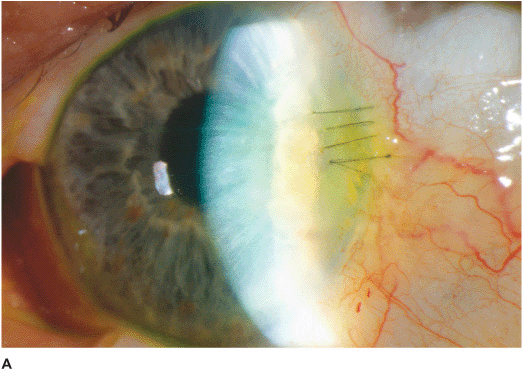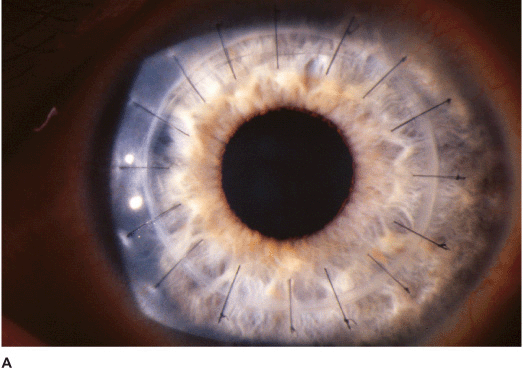SURGERY AND COMPLICATIONS
CATARACT EXTRACTION AND INTRAOCULAR LENS IMPLANTATION
Cataract extraction and intraocular lens (IOL) implantation involves removal of a cloudy crystalline lens and replacement with an artificial lens. It is one of the most commonly performed surgical procedures.
Indications
• Visually significant lens opacity
• Rarely, a cataract causing intraocular inflammation and/or glaucoma
Surgical Technique
Anesthesia Topical or local.
Extracapsular Method A large limbal incision is made near the limbus, an anterior capsulotomy is performed, the lens nucleus is prolapsed out of the eye, the residual cortical material is removed, an IOL is placed, and the wound is sutured.
Phacoemulsification Method A small limbal or clear corneal incision is made, an anterior capsulotomy is performed, the lens nucleus is fragmented and removed with an ultrasound probe, the residual cortical material is removed, and an IOL is placed. Often, no sutures are required.
Postoperative Management Topical corticosteroid and antibiotics.
Complications
Intraoperative
• Expulsive hemorrhage
• Vitreous prolapse
• Lens material falls into posterior segment
• Phacoemulsification burn (Figure 10-1A)
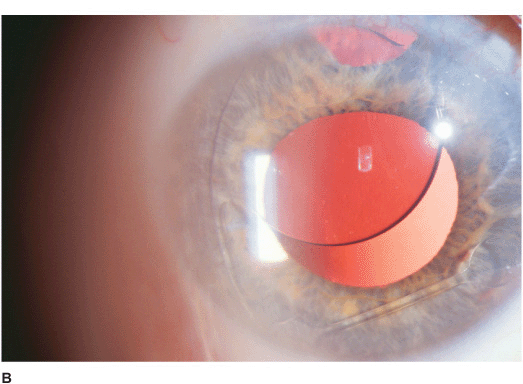
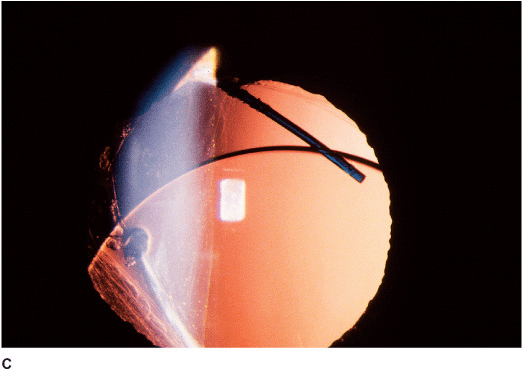
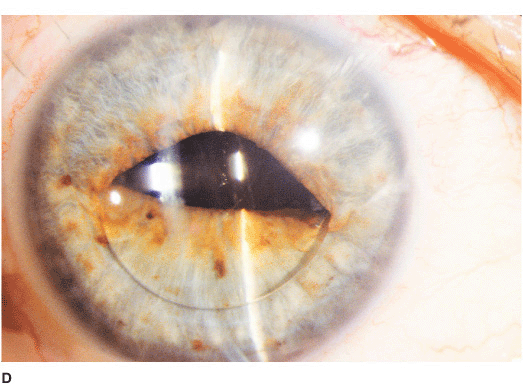
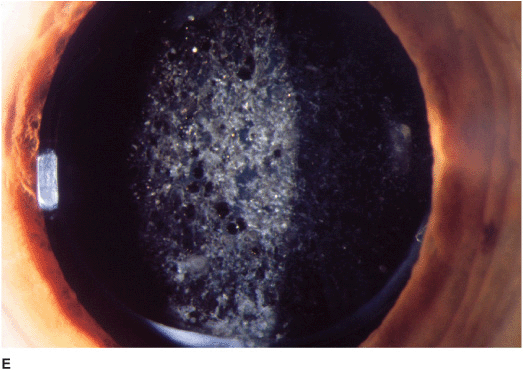
Figure 10-1 Phacoemulsification burn A. This eye withstood a phacoemulsification burn during temporal clear corneal cataract surgery. A phacoemulsification burn during cataract surgery is caused, at least in part, by inadequate cooling of the phacoemulsification handpiece tip during use, causing a thermal burn at the wound. It can occur very quickly, within seconds. The wound required 5 sutures to close. There are significant corneal striae due to the tightness of the sutures required to keep the wound watertight. Intraocular lens subluxation B. This anterior chamber intraocular lens is superiorly subluxed. The superior haptic has migrated through the superior peripheral iridectomy allowing the inferior haptic to come out of the angle and intermittently contact the inferior corneal endothelium, causing corneal edema. C. This posterior chamber intraocular lens has subluxed inferiorly. An oblique rent in the posterior capsule can be seen, compromising capsular support. An inferior subluxation is often termed a “sunset syndrome.” Pupillary capture D. This posterior chamber intraocular lens is partially captured by the iris in this eye 2 weeks after cataract surgery. It was repositioned in the posterior chamber in the operating room. Posterior capsular opacity E. A moderate posterior capsular opacity is evident in this eye several years after cataract surgery. Fibrosis of the initially clear posterior capsule often occurs after cataract surgery and can affect visual clarity. Note the arc of opacified anterior capsular rim inferiorly and the fibrotic posterior capsule centrally. When this affects visual function, treatment is with a laser capsulotomy.
Postoperative
• Endophthalmitis
• Wound leak, wound infection
• Cystoid macular edema
• Glaucoma
• Retinal detachment
• IOL subluxation or dislocation; pupillary capture of IOL (Figures 10-1B,C,D)
• Traumatic wound rupture
• Posterior capsular opacity (PCO), very common (Figure 10-1E)
Success Rate
• Excellent. PCO may require a laser capsulotomy.
CORNEAL TRANSPLANTATION (PENETRATING KERATOPLASTY)
Penetrating keratoplasty involves removal of diseased host tissue and replacing it with full-thickness normal donor cornea. It is one of the most successful transplant operations today, depending on the primary corneal disease.
Indications
Optical To improve vision.
Tectonic To restore the structural integrity of the eye.
Therapeutic Usually performed to remove infected and/or perforated corneal tissue that is not responsive to medical treatment.
Pain To improve pain from chronic bullous keratopathy.
Cosmetic To restore a more normal appearance to the eye.
• Most common indications for penetrating keratoplasty are aphakic or pseudophakic bullous keratopathy, regrafts, keratoconus, corneal dystrophies, and infectious and traumatic corneal scarring.
Donor Tissue
Contraindications for use as donor cornea:
• Death of unknown cause
• Death from central nervous system diseases of unknown etiology
• Central nervous system infections (e.g., Creutzfeldt-Jakob disease, subacute sclerosing panencephalitis, progressive multifocal leukoencephalopathy)
• Systemic infections (e.g., AIDS, viral hepatitis, rabies, septicemia, cytomegalovirus infection)
• Reye’s syndrome
• Lymphoma and leukemia
Unfavorable Prognostic Factors
• Severe stromal vascularization
• Previous graft rejection
• Decreased corneal sensation (e.g., herpes keratitis)
• Pediatric patients
• Active uveitis
• Significant anterior synechiae
• Uncontrolled glaucoma
• Active corneal or intraocular infection
• Severe dry eyes
• Ocular surface inflammation, cicatrization, and keratinization
• Significant limbal stem cell deficiency
• Extreme thinning or irregularity at the intended graft-host junction
• Eyelid disorders: ectropion, entropion, exposure
Surgical Technique
Anesthesia Local or general anesthesia.
Preparation of Operative Eye Often, placement of a Flieringa ring helps to stabilize the globe.
Determination of Graft Size Routine graft sizes vary from 7.25 mm to 8.5 mm.
Trephination of Donor Cornea Typically performed using a posterior endothelial punch method. The trephine is usually 0.25 to 0.5 mm larger than that for host cornea trephination.
Excision of Host Cornea Trephination of host cornea can be done by using a manual trephine (e.g., Weck trephine) or a vacuum trephine (e.g., Barron-Hessburg or Hanna trephine). A partial-thickness trephination is first carried out, the anterior chamber is then entered using a blade, and finally excision is completed using corneal scissors.
Wound Closure Various suture methods, including interrupted, running, double running, or a combination may be used. 10-0 nylon is usually used (Figures 10-2A,B,C).
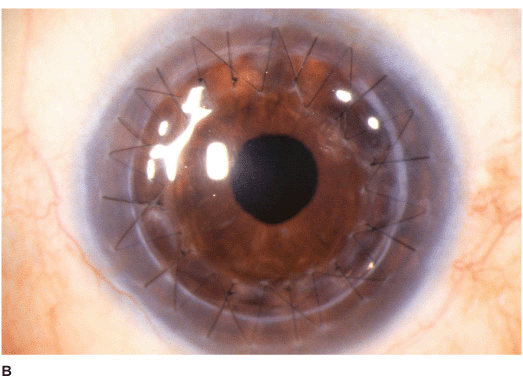
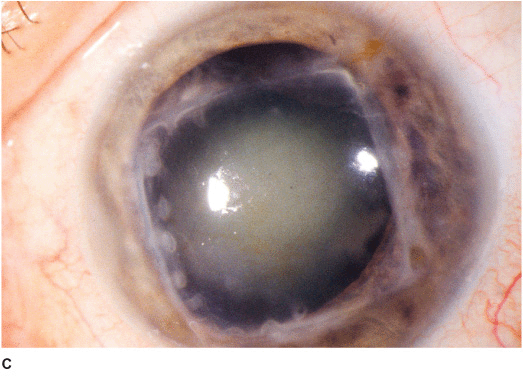
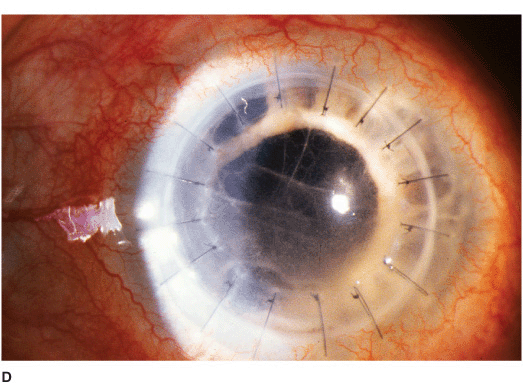
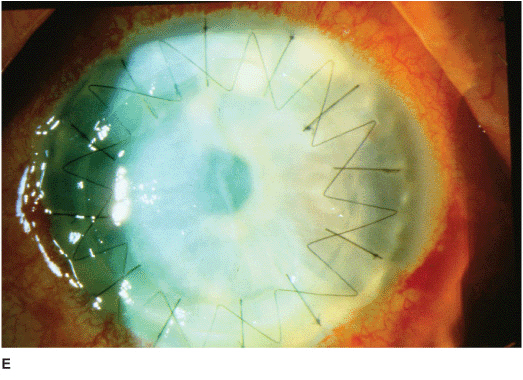
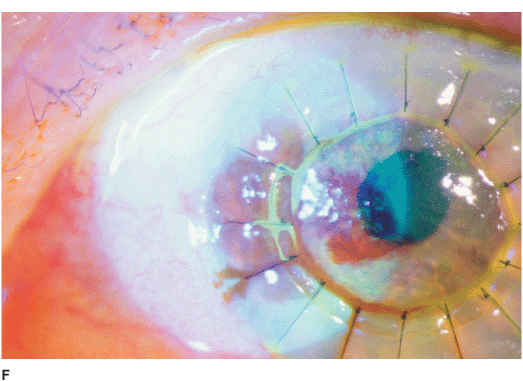
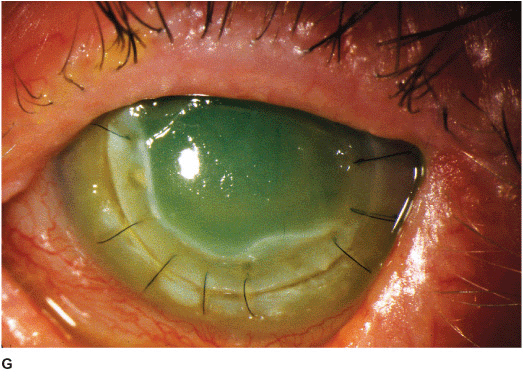
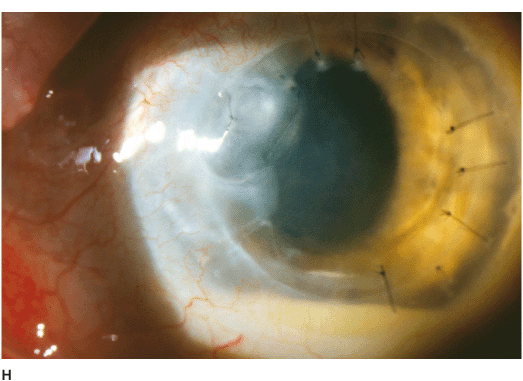
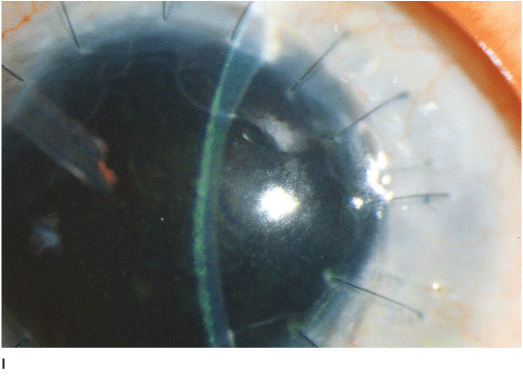
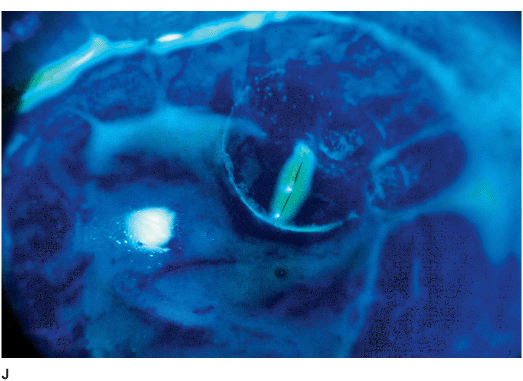
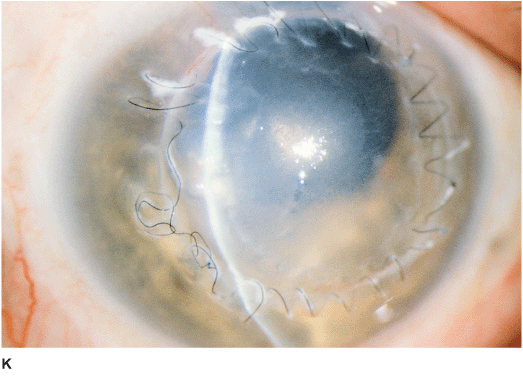
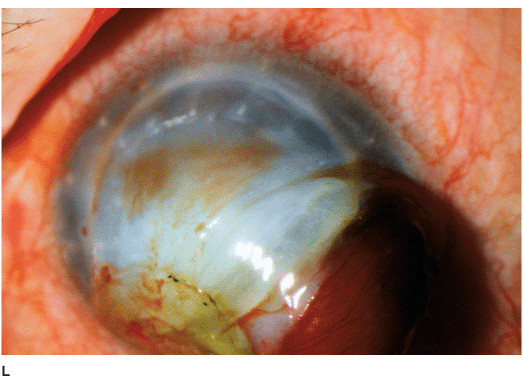
Figure 10-2 Corneal transplant A. A clear corneal transplant is seen 6 weeks after surgery for herpes simplex scarring. Sixteen interrupted 10-0 nylon sutures are in place. B. A clear corneal transplant is seen 6 months after a corneal transplant, cataract extraction, and posterior chamber intraocular lens implant for Fuchs’ dystrophy and cataract. Twelve interrupted and 12 bite running 10-0 nylon sutures are present. C. An old square corneal transplant performed by Dr. Castroviejo in New York City about 40 years earlier. The graft remains remarkably clear, although a cataract is developing. Corneal transplant complication—early endophthalmitis D. Ten days after a corneal transplant, severe intraocular inflammation with fibrin in the anterior chamber and a small hypopyon at the graft-host margin inferiorly can be seen. Endophthalmitis was suspected and a vitreous tap revealed Staphylococcus epidermidis which responded well to antibiotic treatment. Corneal transplant complication—primary graft failure E. Diffuse severe corneal edema with whitening of the corneal stroma is present 1 day after a corneal transplant in an eye with primary graft failure. Primary graft failure generally occurs due to poor-quality tissue or damage to the corneal endothelium during surgery. Corneal transplant complication—wound leak F. A wound leak is seen 3 days after a corneal transplant. Dark, concentrated fluorescein dye was placed at the graft–host margin at the 9 o’clock position. Aqueous fluid leaking through the graft–host wound can be seen to dilute the dye and turn it bright yellow-green. If the leak is minimal and the anterior chamber is formed, it can be treated medically and followed closely. If the leak is significant or the chamber is flat, the leak should be repaired surgically. Corneal transplant complication—wound melt G. A severe corneal wound melt is present in the inferior half of this cornea 5 months after a corneal transplant. Multiple loose sutures can be seen. A small, permanent lateral tarsorrhaphy had already been performed. Corneal transplant complication—suture abscess H. A broken corneal transplant suture and underlying abscess are present at the 10 o’clock position. A large hypopyon with a second small hypopyon at the graft–host junction can be seen inferiorly. Corneal transplant complication—epithelial downgrowth I. A curvilinear retrocorneal membrane can be seen from 9 o’clock toward 12 o’clock and back down toward 3 o’clock. It is again visible around 5 o’clock. It advanced centrally over several weeks. It was diagnosed as epithelial downgrowth. Corneal transplant complication—broken interrupted suture J. A broken corneal transplant suture is present at the 2 o’clock position. Fluorescein dye and the cobalt blue light demonstrate the “windshield wiper” effect of the broken suture. Corneal transplant complication—loose, exposed running suture K. An extremely loose and exposed running suture can be seen a year after a corneal transplant. There is mucus adherent to the suture and secondary peripheral corneal neovascularization superiorly and corneal edema centrally. Expulsive hemorrhage after a corneal transplant wound dehiscence L. Several years after a penetrating keratoplasty, blunt trauma caused the wound to dehisce and resulted in an expulsive hemorrhage. Note the large clot of blood exiting the wound. Iris pigment and vitreous jelly can be seen on the inferior cornea.
Postoperative Management Topical corticosteroid and antibiotics.
Combined Procedures
Where indicated, penetrating keratoplasty can be combined with any of the following procedures:
• Cataract extraction with intraocular lens implantation (triple procedure)
• Anterior vitrectomy with intraocular lens implantation
• Intraocular lens exchange, either anterior chamber lens or scleral fixated posterior chamber lens
• Glaucoma drainage devices or trabeculectomy
• Posterior vitrectomy, possibly with a temporary keratoprosthesis
Complications
Intraoperative
• Eccentric, tilted, or irregular trephination of host or donor cornea
• Damage to iris or lens
• Expulsive hemorrhage
• Vitreous prolapse
Postoperative
SIGHT-THREATENING
• Endophthalmitis (Figure 10-2D)
• Glaucoma
• Retinal detachment
• Cataract
• Cystoid macular edema
GRAFT-THREATENING
• Primary failure: endothelial damage during surgery, poor quality donor tissue (Figure 10-2E)
• Wound leak (Figure 10-2F)
• Persistent epithelial defect (Figure 10-2G)
• Flat anterior chamber (typically from a wound leak or angle-closure glaucoma)
• Immunologic rejection
• Infectious keratitis, suture abscess (Figure 10-2H)
• Recurrence of disease: dystrophies, infection
• Epithelial downgrowth and retrocorneal fibrous membrane (Figure 10-2I)
• Vitreous touch
OTHERS
• Broken suture (Figures 10-2J,K)
• Iris prolapse
• Wound dehiscence
• Traumatic wound rupture (Figure 10-2l)
• Irregular astigmatism
Success Rate
• Poor to excellent, depending on the indication for surgery.
LAMELLAR KERATOPLASTY
Lamellar keratoplasty involves removal of the anterior cornea and replacing it with partial-thickness normal donor cornea.
Advantages
• Donor endothelial cell density is not important.
• The anterior chamber is not entered, therefore complications such as expulsive hemorrhage and endophthalmitis are avoided.
• No risk of endothelial rejection.
Disadvantages
• Technical complexity of the procedure.
• Opacification of the lamellar interface which may reduce visual acuity.
Indications
• Anterior corneal scars and dystrophies
• Recurrent pterygium
• Limbal dermoid
• Peripheral ulcerative keratitis
• Terrien’s marginal degeneration
• Rarely, keratoconus, infectious keratitis, superficial corneal tumors
Surgical Technique
Anesthesia Local or general anesthesia.
• Partial thickness corneal trephination (encompassing the pathology) is performed on the recipient cornea.
• Lamellar dissection is then carried out on the recipient cornea using a blunt dissecting blade.
• Donor lamellar cornea is dissected and trephined. It should be 0.25 to 0.5 mm larger than the recipient bed. Either a whole eye or a corneoscleral button fixated in an artificial chamber can be used.
Stay updated, free articles. Join our Telegram channel

Full access? Get Clinical Tree


